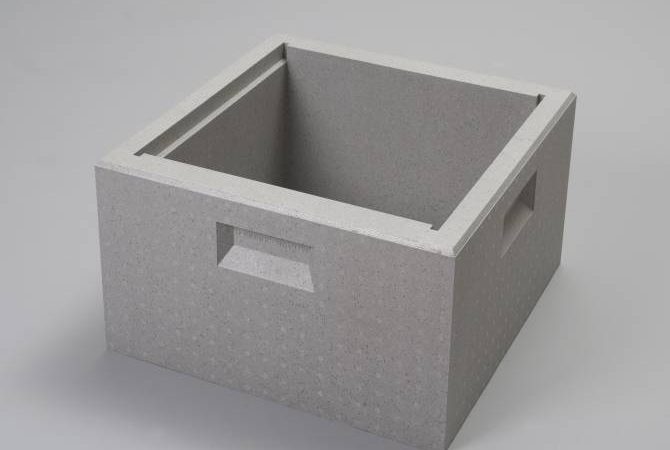EPS – expanded polystyrene – is a lightweight and environmentally friendly material consisting of 98% air and 2% polystyrene (plastic). In Denmark, it is known under the brand name Flamingo.
When goods are packaged in packaging, it basically serves one or more of the following purposes:
- The packaging can protect the packaged item.
- The packaging can group several goods together for easier transport.
- The packaging can ensure that important information about the product is easily accessible.
- The packaging can be used to increase sales.
The main reason for using EPS packaging is that you want to protect the product. Either because of the shock-absorbing properties, like when using a bicycle helmet to protect the head (which, incidentally, is also made of EPS). Or because the transported item needs the insulating properties of EPS, which is particularly relevant in, for example, fish or food boxes.
Naturally, EPS packaging can also be designed so that it can be used to keep multiple units of the product together – and by putting a label on the packaging, EPS can communicate important information. By contrast, the purpose of EPS as packaging is to a very limited extent to strengthen sales.
Thus, the choice of EPS as packaging is measured based on functionality and sustainability. Two parameters on which the material stands strong. Whether EPS is functionally the best solution depends on the specific needs. However, comparing all relevant parameters is always key. If the product to be protected releases condensation or is moist, one should take into account that an alternative packaging of e.g. cardboard must be given a protective plastic surface.
EPS packaging, foodstuffs and sustainability:
- In general, when it comes to “environmental impact in relation to food production, about 80 percent comes from food production, about 15 percent from transport and distribution, while only about 5 percent comes directly from the packaging. Food waste is thus a far greater climate sinner than packaging.”(1)
- The UN estimates that approx. 33% of all food ends up as food waste. The carbon footprint of this food waste corresponds to approx. 50% of the total climate footprint of the US.(2) A report from the UK authorities has shown that up to 50% of all food is wasted before reaching stores in developing countries. In England, the figure is 3%. The reason may be attributed to adequate and proper use of packaging.(3)
- Studies have shown that EPS boxes are best at keeping fish cool. Other studies have shown that EPS packaging is the most effective material for storing and transporting fruits and vegetables.(4)
EPS packaging and sustainability:
- Studies have shown that a switch from plastic to the best available alternative will double the energy consumption for packaging production and there will be a tripling of CO2 emissions.(5)
- EPS is 100% recyclable. Members of EPS-branchen have been working on recycling the material since 1995. Depending on the design and purpose, up to 20% of EPS in new products is recycled scraps and off-cuts from production or collected and recycled EPS, which is granulated. Thus, there is virtually no waste from the production of EPS.
- If EPS raw materials are used based on recycled EPS, the carbon footprint from raw material production of polystyrene pellets can be reduced by more than 70%.(6) If recycled EPS is compared to the best available alternatives, the alternative to EPS will emit over 8 times as much CO2.(7)
- EPS consists of 98% air and only 2% of raw material and therefore weighs considerably less than alternative packaging. Thus, a shift to alternative materials will entail higher transport costs and greater climate impacts. For example, fish boxes weighing 3.5 times EPS boxes require more than 3 times as much fuel and emit more than 3 times as much CO2. This corresponds to more than 3% of the total freight.(8)
Correct packaging reduces the world’s total resource consumption because packaging prevents the product from breaking and then having a need to replace it. A number of life cycle analyses (LCAs) have shown that EPS has a better environmental and climate profile than alternative packaging solutions.(9)
EPS offers extra good protection because it is 98% air. This makes the material a bit like an airbag, effectively absorbing shock impacts. At the same time, the air acts as insulation for items that need to be kept warm or cold.
Also, when properly collected, EPS is a clean waste fraction that is easily recyclable. Alternative packaging, which consists of several types of materials, must first be separated before they can be recycled.
EPS packaging, if requested by the customer, can meet all the criteria for sustainable packaging, as outlined by the American organisation Sustainable Packaging Coalition.(10)
This is also one of the reasons why EPS packaging is a sustainable choice.
Sources
(1) https://www.teknologisk.dk/ydelser/skal-vi-pakke-vores-foedevarer-ind-i-bananblade/41161
(2) http://www.fao.org/3/a-bb144e.pdf
(3) https://www.bbc.com/news/business-47161379
(4) For more, see https://eps-airpop.dk/fiskekasser-af-eps/
(5) https://www.hw.ac.uk/news/articles/2018/a-plastic-ban-could-increase-damage-to.htm
(6) https://www2.mst.dk/Udgiv/publikationer/2019/08/978-87-7038-094-2.pdf
(7) Own estimates based on https://www.hw.ac.uk/news/articles/2018/a-plastic-ban-could-increase-damage-to.htm and https://www2.mst.dk/Udgiv/publikationer/2019/08/978-87-7038-094-2.pdf
(8) Calculated through http://gronberegner.teknologisk.dk/
(9) Find examples here https://eps-airpop.dk/publikationer/
(10) https://sustainablepackaging.org/wp-content/uploads/2017/09/Definition-of-Sustainable-Packaging.pdf

